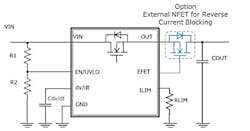E-Fuse Family Adds Features, Functionality to Basic Fuse Role
The traditional thermally activated overcurrent-protection “sacrificial” fuse does one thing and does it well, which is both its strength and weakness. Electronic fuses (commonly referred to as e-fuses or efuses) are increasingly challenging these venerable fuses due to the flexibility and features they offer, providing performance and operational advantages across many applications.
Toshiba Electric has entered the e-fuse market with a family of six devices featuring highly accurate overcurrent limit, overvoltage protection, and overtemperature protection, in addition to short-circuit protection. Compared to polymeric positive temperature coefficient (PPTC) devices that are also resettable, they react much faster, can be reset directly via an external logic signal, and retain their low on-resistance even after multiple trip events.
The members of the TCKE8xx series come in three categories: no overvoltage VOVC protection, 5 V (VOVC = 6.04 V), and 12 V (VOVC = 15.1 V); each category is offered in both auto-retry or latched options after a fault event. The status of the latch type is determined by application of an external signal, while the auto-retry is capable of re-enabling its output automatically. The fast-trip comparator can switch off the output typically within 150 ns, far faster than a fusible link and a better fit with the needs of sensitive electronics.
Functions available with these e-fuses include:
- Quick short-circuit protection: The ultra-high-speed short-circuit protection technique provides basic role.
- High-precision overcurrent protection: User-set via external resistors.
- High-precision overvoltage clamp function: Prevents excessive voltage from being applied to the load ICs by clamping the outputs for instantaneous voltage increases.
- Ability to suppress inrush current: An external capacitor can be added to reduce inrush current by setting a turn-on slew-rate at the output as desired.
- Thermal shutdown function and recovery operation: If a fault condition persists for a long time such that the IC temperature exceeds the set temperature, the IC goes to a standby state to shut off the output and prevent the output from being damaged by the thermal shutdown function.
Furthermore, an external N-channel MOSFET can be added for reverse-current blocking protection, often mandated in automotive and other applications (see figure).
These e-fuses are housed in 3.00- × 3.00-mm, 0.75-mm-high WSON10B packages, with typical RON of just 28 mΩ and an overcurrent limit accuracy of ±11% over the −40 to +85°C range. Input voltages of 4.4 to 18.0 V are supported and output currents can be as high as 5.0 A. Their certification to IEC 62368-1 eases the path to certification testing and approval of the overall product. More information on the Toshiba Electric TCKE8xx series is available here.

